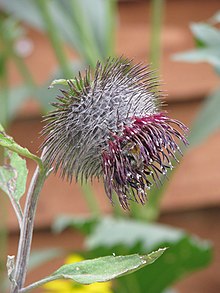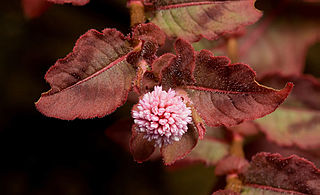
Persicaria is a genus of herbaceous flowering plants in the knotweed family, Polygonaceae. Plants of the genus are known commonly as knotweeds or smartweeds. It has a cosmopolitan distribution, with species occurring nearly worldwide. The genus was segregated from Polygonum.
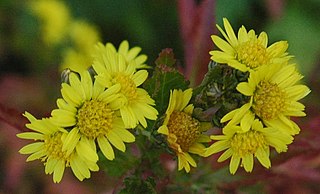
Chrysanthemums, sometimes called mums or chrysanths, are flowering plants of the genus Chrysanthemum in the family Asteraceae. They are native to East Asia and northeastern Europe. Most species originate from East Asia and the center of diversity is in China. Countless horticultural varieties and cultivars exist.

Acorus is a genus of monocot flowering plants. This genus was once placed within the family Araceae (aroids), but more recent classifications place it in its own family Acoraceae and order Acorales, of which it is the sole genus of the oldest surviving line of monocots. Some older studies indicated that it was placed in a lineage, that also includes aroids (Araceae), Tofieldiaceae, and several families of aquatic monocots. However, modern phylogenetic studies demonstrate that Acorus is sister to all other monocots. Common names include calamus and sweet flag.

Shibataea is a genus of Chinese bamboos in the grass family.
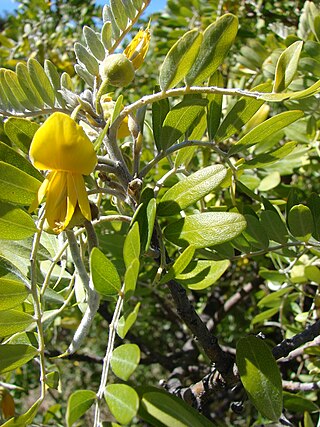
Sophora is a genus of about 45 species of small trees and shrubs in the pea family Fabaceae. The species have a pantropical distribution. The generic name is derived from sophera, an Arabic name for a pea-flowered tree.

Elaeagnus is a genus of about 50–70 species of flowering plants in the family Elaeagnaceae. Species of the genus are commonly known as silverberry or oleaster,

Arisaema is a large and diverse genus of the flowering plant family Araceae. The largest concentration of species is in China and Japan, with other species native to other parts of southern Asia as well as eastern and central Africa, Mexico and eastern North America. Asiatic species are often called cobra lilies, while western species are often called jack-in-the-pulpit; both names refer to the distinctive appearance of the flower, which consists of an erect central spadix rising from a spathe.

Osmunda japonica, also called Asian royal fern or fiddlehead, is a fern in the genus Osmunda native to east Asia, including Japan, China, Korea, Taiwan, and the far east of Russia on the island of Sakhalin. It is called gobi in Korean, zenmai in Japanese, and zǐqí or juécài in Chinese.

Takenoshin Nakai was a Japanese botanist. In 1919 and 1930 he published papers on the plants of Japan and Korea, including the genus Cephalotaxus. During the Japanese occupation of the (former) Dutch East Indies Takenoshin Nakai was between 1943 and 1945 the director of 's Lands Plantentuin in Batavia (now: Bogor Botanical Gardens in Bogor.

The Cardueae are a tribe of flowering plants in the daisy family (Asteraceae) and the subfamily Carduoideae. Most of them are commonly known as thistles; four of the best known genera are Carduus, Cynara, Cirsium, and Onopordum.
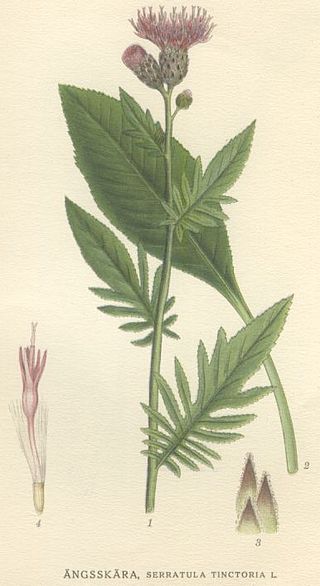
Serratula is a genus of plants in the tribe Cardueae within the family Asteraceae native to Eurasia. Plumeless saw-wort is a common name for plants in this genus. Serratula as traditionally defined contains at least two groups: one of which is basal within the subtribe Centaureinae and one of which is derived; the former group can be moved to the genus Klasea.
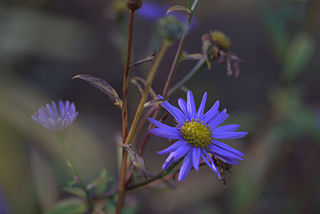
Miyamayomena is a genus of East Asian flowering plants in the tribe Astereae within the family Asteraceae.

Tugarinovia is a genus of East Asian plants in the tribe Cardueae within the family Asteraceae.

Hololeion is a genus of East Asian flowering plants in the family Asteraceae. It is native to Japan, Korea, China, and the Russian Far East.
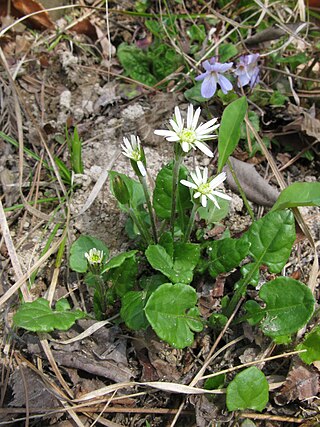
Leibnitzia (sunbonnets) is a genus of Asian and North American flowering plants in the family Asteraceae.

Crepidiastrum is an Asian genus of flowering plants in the family Asteraceae.

Chrysanthemum lavandulifolium is a flowering plant within the family Asteraceae and the genus Chrysanthemum. It is a perennial flowering plant that is often noted because of its yellow flowers. It has 18 chromosomes at the diploid stage.

Zabelia is a genus of flowering plants in the family Caprifoliaceae. It includes eight species native to temperate Asia, ranging from Central Asia through the Himalayas to China, Korea, and Japan.
